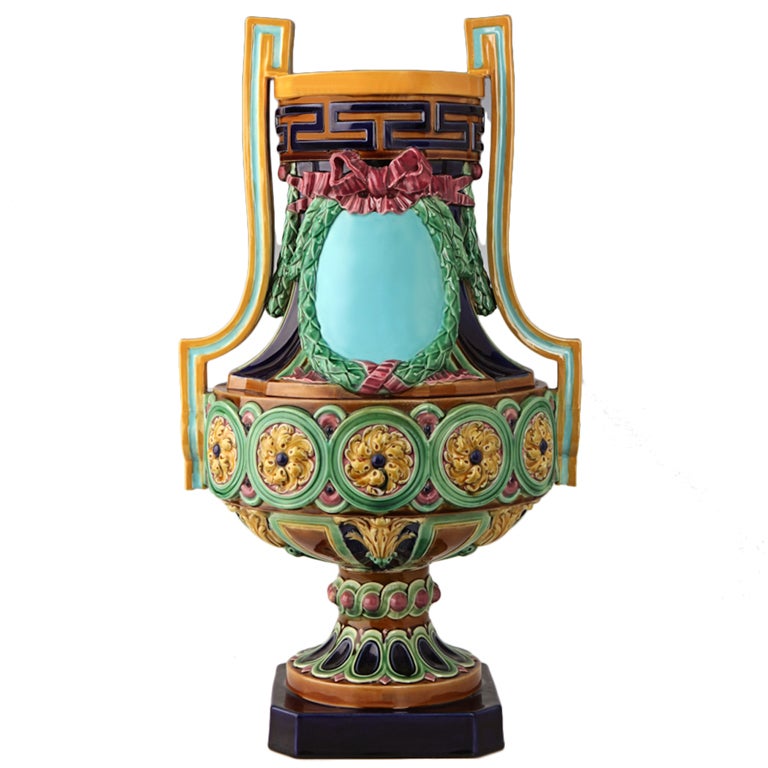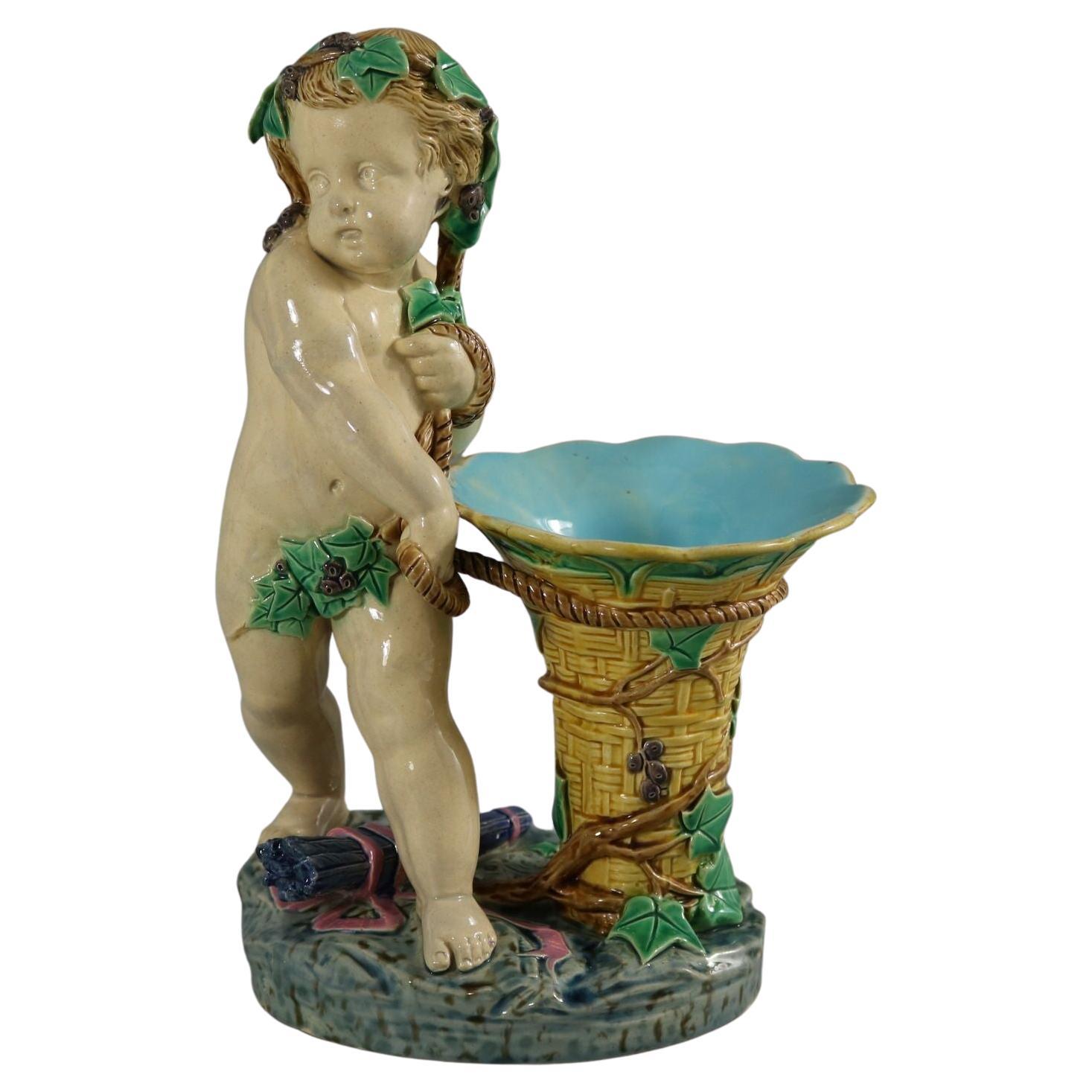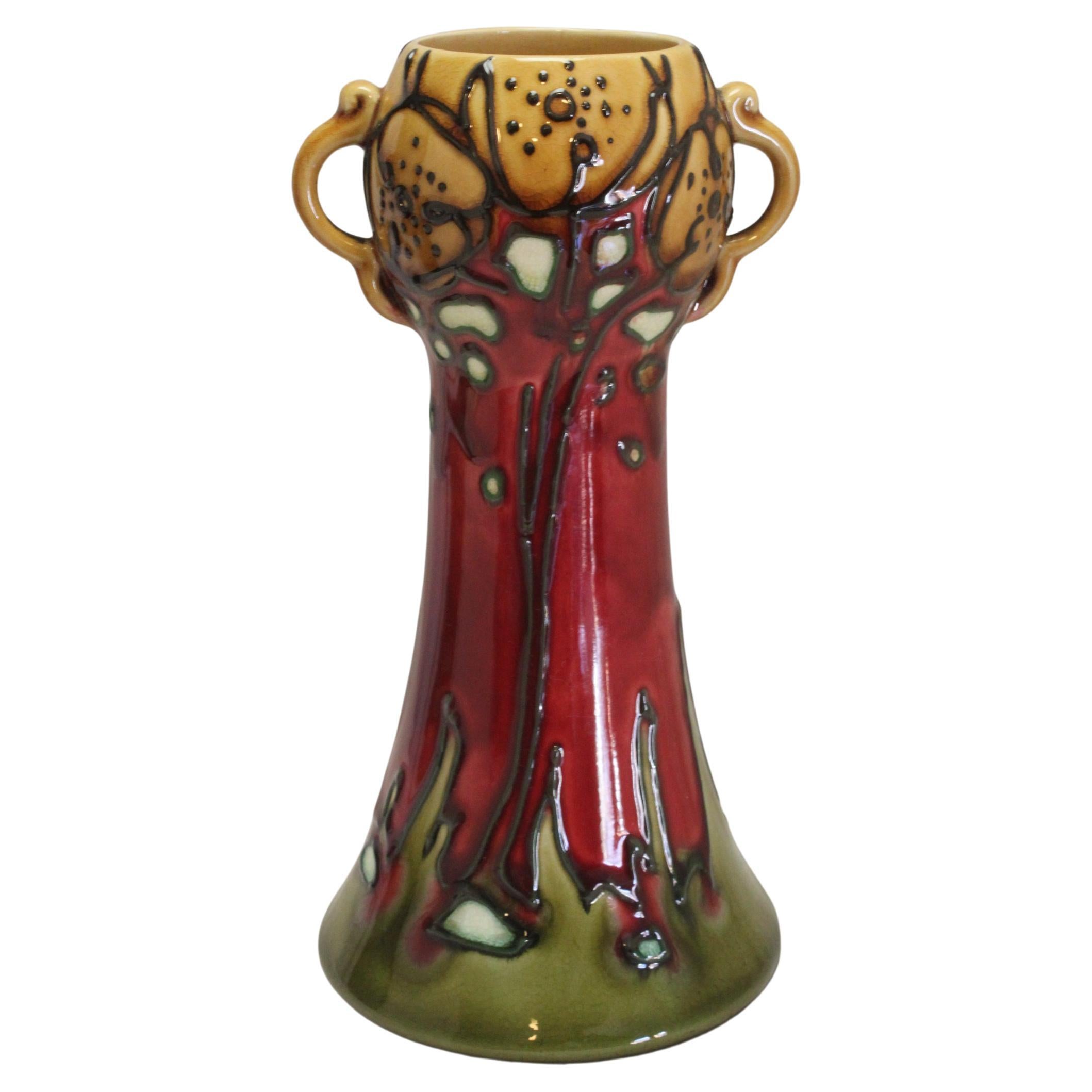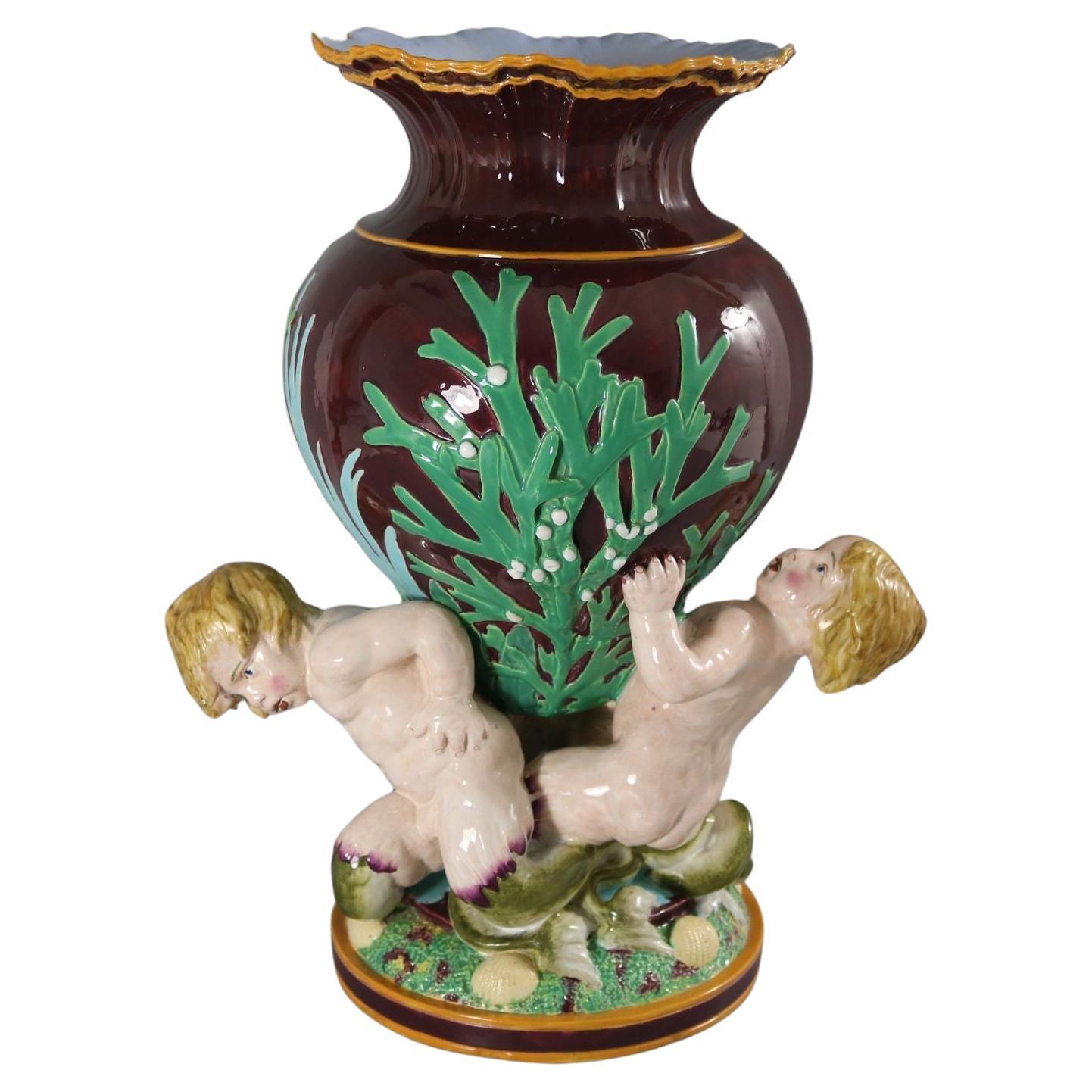Christopher Dresser Faux Cloisonne Vases for Mintons
About the Item
- Creator:Minton (Maker)
- Dimensions:Height: 16.25 in (41.28 cm)Width: 8 in (20.32 cm)Depth: 8 in (20.32 cm)
- Style:Chinoiserie (Of the Period)
- Materials and Techniques:
- Place of Origin:
- Period:
- Date of Manufacture:circa 1870s
- Condition:Repaired: Rubbing wear throughout, and signs of restoration to chip losses to the undersides. Wear consistent with age and use.
- Seller Location:New York, US
- Reference Number:
Minton
Pottery is one of the oldest decorative art forms, and Minton is one of its historical masters. For more than 250 years, the English company was a premier producer of porcelain and ceramic wares. Its factory was known for detailed and brightly colored Victorian tableware, including dinner plates and serving pieces.
Thomas Minton founded the Minton factory in 1793 in Stoke-upon-Trent, England. It initially made earthenware but introduced bone china in 1798. When Minton died in 1836, the company passed to his son, Herbert Minton. The younger Minton was a savvy businessman with an eye for design. He introduced glossy majolica earthenware to the factory’s repertoire and hired skilled artists and designers like Augustus Welby Northmore Pugin and Albert-Ernest Carrier-Belleuse, boosting the company’s reputation.
In 1851, Minton debuted its majolica at the Great Exhibition in London. It became a royal family favorite and was even used to tile the Royal Dairy at Windsor Home Park. Minton majolica was also displayed on the monumental Saint George and the dragon fountain at the 1862 London International Exhibition.
Colin Minton Campbell, a nephew of Herbert Minton, took over the family business in 1858. He led the company to the head of the 1870s English art pottery movement. In the 1890s, French porcelain artist Marc-Louis Solon helped modernize Minton with his Art Nouveau designs.
Minton ceased operating as an independent company when it merged with Royal Doulton Tableware Ltd. in 1968. It was the end of an era, but not the end of widespread appreciation for Minton ceramics.
In 1982, the ”English Majolica” exhibition at the Cooper Hewitt, Smithsonian Design Museum featured 75 Minton pieces. When the Metropolitan Museum of Art reopened its British Galleries in 2020, it included a display of three colorful Minton majolica bird sculptures. Minton pottery was also on display from September 2021 to January 2022, along with other English pottery, at the Bard Graduate Center’s ”Majolica Mania” exhibition.
On 1stDibs, find exquisite Minton serveware, decorative objects, wall decorations and more.
- ShippingRetrieving quote...Ships From: New York, US
- Return PolicyA return for this item may be initiated within 2 days of delivery.
- English Faux Bois Majolica Garden Seat Attributed to MintonBy MintonLocated in New York, USOur faux bois garden chair in the form of a tree stump with assembled arms and seatback dates from the 1870s and is attributed to Mintons of Staffordshire, England. In good condition...Category
Antique Late 19th Century British Late Victorian Garden Ornaments
MaterialsCeramic
- Pair Jasper Stone VasesLocated in New York, USOur pair of antique vases are carved from reddish brown jasper stone and date from the late nineteenth century. In good condition with scratches and small...Category
Antique Late 19th Century European Neoclassical Vases
MaterialsStone
- Monumental Antique Bohemian Gilt Glass VaseBy Harrach GlassworksLocated in New York, USOur very large (33 1/2 inch tall) and elegant gilt-decorated glass vase on stand dates from the third quarter of the 19th century. Attributed by ...Category
Antique Mid-19th Century Czech Neoclassical Vases
MaterialsGlass
- Royal Copenhagen Art Nouveau Vase by Knud Valdemar EngelhardtBy Royal CopenhagenLocated in New York, USOur extraordinary porcelain vase with cover by Knud Valdemar Engelhardt (Danish, 1882-1931) for Royal Copenhagen dates from circa 1916, and features a unique celedon colored crystalline glaze with abstract blue and white flower heads and patinated bronze cover with reticulated finial. Stamped ROYAL COPENHAGEN with three wave painted mark and signed with the artist's cipher, VE and K 9. Provenance: East Asiatic London Co.; Philippe Denys, Galerie Philippe...Category
Vintage 1910s Danish Art Nouveau Vases
MaterialsPorcelain
- Pair Lenti Murano Glass Vases After Ercole BarovierBy Ercole BarovierLocated in New York, USOur beautiful rare pair of Lenti glass vases from Murano, after the innovative series by Ercole Barovier for Barovier, Toso & Co, 1940, are crafted from iridized pale violet glass wi...Category
Late 20th Century Italian Mid-Century Modern Vases
MaterialsArt Glass
- Boucheron Parcel Gilt Silver Vase and Oil Lamp circa 1880By Fréderic BoucheronLocated in New York, USOur important parcel-gilt and patinated silver and glass-mounted vase and matching oil lamp were designed by Paul Legrand (1840-1910) and crafted by the silversmith, Charles Glachant, for Boucheron of Paris, circa 1878-1880. 21 in tall and 16.5 in wide (53.4 by 41.9 cm). 28.56 lbs, 457 oz, 14,210 g. Provenance: presented to or purchased by Jean-Baptiste Pezon (1827-1897); acquired by a European private collector, perhaps on the death of Jean-Baptiste Pezon in 1897, by descent; acquired by YM Antiques, 2017. This double walled vase has an amphora form, with body and foot with silver, gilt and patinated and stylized flowers, anthemions and sprays of cherries against an etched and matted ground pierced to reveal a gilt inner wall. The upper body is detachable via a slip-lock, and mounted on both sides with arched panels formed of hexagonal beveled glass tiles. One glass panel applied with bacchic infants taunting a rearing goat and the other side with infants feeding grapes to a lioness under a looming bust of a satyr. The patinated and gilt upswung loop bifurcated handles are mounted with fully modeled figures of Pan bearing a syrinx and thyrsus and a draped maenad playing two flutes, both above roaring lion heads, the rim inset with a slip-lock detachable gilt bowl etched with masks of various representations of Bacchus spaced by ribbons and trophies and with scrolling fruiting vines. The base of interior with detachable base metal drip pan to accommodate the removable oil lamp designed to illuminate the glass tiles from within. The lamp is raised on four hoof feet, the upturned ends cast underneath with masks and with detachable cover mounted with two infant satyrs and flanked by gilt loop handles. The bacchic themed design featuring cartouches depicting infants taunting a goat and lion, plus prominent lion masks at the handles, certainly appealed to Boucheron's customer, Jean-Baptiste Pezon (1827-1897), who is believed to have commissioned the piece. Pezon was the celebrated lion tamer and headliner of the Grande Menagerie whose profession brought him great fame and fortune in Paris. Born a shepherd boy in Lozere, he is said to have left his home at the age of seventeen in the company of a wolf he had captured and trained years earlier. He headed to Paris and by the age of twenty-one purchased his first lion who he named Brutus. The animal is said to have inspired the Lion of Belfort, the monumental red standstone sculpture by Frederic Bartholdi erected in Belfort in 1880. Toulouse-Lautrec was among his admirers and friends, visiting Pezon's Great Lozerian Menagerie to sketch animals. A large bronze sculpture of Pezon atop a female lion adorns the Pezon family tomb in the Pere Lachaise Cemetery in Paris, as seen in our image here. The vase and detachable bowl are marked on the underside with the silversmith's mark of Charles Glachant. The underside and upper rim of the lower body is engraved "Fic Boucheron Paris". The lamp is marked on underside and flange of cover for Glachant. Boucheron archives indicate the vase was inspired by the amphora vases created by the Greek potter, Nikosthenes, 550-510 BC. The Nikosthenic amphora vases are a form of Attic vase recognized for their angular amphora form with broad flat handles. Potted of bright orange-red clay, they were decorated with plant and animal motifs within distinct friezes, with the most significant defining feature being the black figure painting, often highlighted with white accents. In this vase Legrand re-imagines the striking contrast of the black figures against a warm ground through the use of patina and gilding. His inventive use of piercing and double-wall construction create additional levels of texture and depth throughout the body. The same combination of ornamentation was employed in a ewer designed by Legrand in 1880 in the Islamic taste. (See lot 77 of Christie's sale in New York on October 22, 2009.) Edmé Bouchardon (1698-1762), royal sculptor to Louis XV, may have provided Legrand with inspiration for the vase's iconography. The panel featuring bacchic infants taunting a rearing goat is very similar to a bas relief representation of Winter designed by Bouchardon for the Fontaine des Quarte-Saisons on rue de Grenelle, Paris. Bouchardon debuted his plaster model for the bas relief in 1741, and the fountain was completed in 1745. The Boucheron firm, founded by the celebrated jeweler, Frédéric Boucheron...Category
Antique 1880s French Greek Revival Vases
MaterialsSilver
- Huge Minton Majolica VaseBy MintonLocated in Litchfield, CTCirca 1870, by Minton, England. A gorgeous example of English porcelain, this monumental vase is a Victorian Aesthetic movement tour de force. Majolica by Minton is known for its del...Category
Antique 19th Century English Neoclassical Vases
MaterialsPorcelain
- Minton Majolica Cats Head VaseBy MintonLocated in New York, NYMagnificent 19th century English Minton Majolica "Queen's vase" with cat heads. This rare model an amphora shape vase in rich Majolica gold, green and blue c...Category
Antique 19th Century English Victorian Vases
MaterialsMajolica
- Minton Majolica Putti with Basket VaseBy MintonLocated in Chelmsford, EssexMinton Majolica figural vase which features a putti holding a basket, with a quiver of arrows between his feet. Colouration: cream, yellow, blue, are predominant. The piece bears mak...Category
Antique 1860s Victorian Vases
MaterialsMajolica
- Mintons Majolica Putti Flower Holder VaseBy MintonLocated in Chelmsford, EssexMinton Majolica flower holder which features a putti wearing drapes, carrying a cornucopia vase. Colouration: green, turquoise, white, are predo...Category
Antique 1870s English Victorian Vases
MaterialsMajolica
- Minton Secessionist Ware Vase Number 41By MintonLocated in East Geelong, VICThis Minton Secessionist ware vase stands 176 mm (7 inches) high, and has a diameter at the base of 90 mm (3.5 inches). This design is illustrated ...Category
Antique Early 1900s English Art Nouveau Vases
MaterialsEarthenware
- Minton Majolica Marine Vase with MerboysBy MintonLocated in Chelmsford, EssexMinton Majolica vase which features three merboys supporting a vessel adorned with seaweeds. The rim of the vase is modelled to depict breaking waves. Dark maroon ground version. Col...Category
Antique 1860s Vases
MaterialsMajolica






